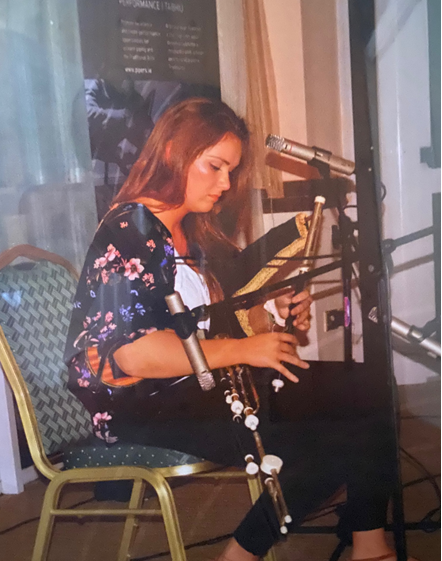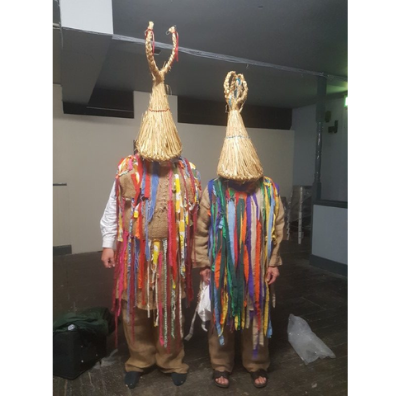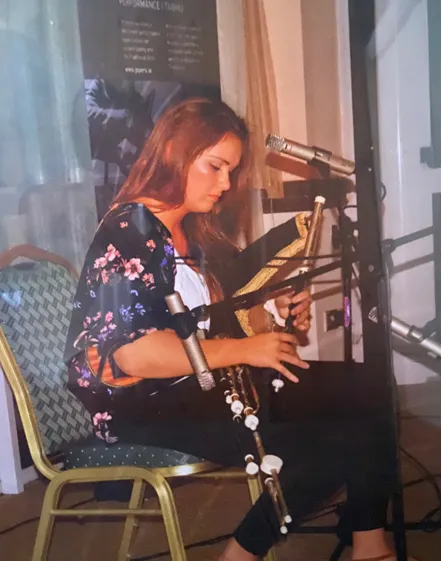This blog post records how, on 19 August, practitioners from three performing arts joined Manchán Magan for a lively evening of performance, exploration, and discussion on the theme of intangible cultural heritage.
Performing, Promoting and Preserving Ireland’s Intangible Cultural Heritage from Digital Repository of Ireland on Vimeo.
On 19 August practitioners from three performing arts joined Manchán Magan for a lively evening of performance, exploration, and discussion on the theme of intangible cultural heritage. The event was co-organised by the Department of Tourism, Culture, Arts, Gaeltacht, Sport and Media and the Digital Repository of Ireland, as a contribution to National Heritage Week 2021.
In December 2015, Ireland ratified the UNESCO 2003 Convention for the Safeguarding of the Intangible Cultural Heritage. Also known as ‘living heritage’, this term ‘refers to the practices, representations, expressions, knowledge, skills – as well as the instruments, objects, artefacts and cultural spaces associated therewith – that communities, groups and, in some cases, individuals recognize as part of their cultural heritage’. The National Inventory for Intangible Cultural Heritage has been established to protect, promote and celebrate Irish living cultural heritage practices, customs, crafts and traditions. This live event was designed to showcase these practices to an even wider audience and to stimulate a discussion on how they are being continued by, and for, younger generations.
‘The Sound of Ireland’: hearing and seeing the Uilleann pipes
One of the diverse practices included in the National Inventory is Uilleann Piping, which is ‘a musical practice which uses a particular type of bagpipe (known as the ‘uilleann’, ‘Irish’, or ‘union’ pipes) to play Irish music’. Claire Fennell joined us from non-profit organisation Na Píobairí Uilleann to talk us through the different components of the pipes, before giving us an opportunity to hear what they sound like when played together. Claire explained to moderator Manchán Magan that she was supported by Na Píobairí Uilleann to begin learning the pipes at age 16, and has been listening to and being inspired by older pipers ever since. Claire was then joined by Na Píobairí Uilleann archivist Emmett Gill, who shared some fascinating information about the organisation, which was founded in 1968 when there were less than 100 pipers in the world. He told Manchán that ‘people just seem to identify with the sound of the pipes’, and that piping has been called ‘the sound of Ireland’. He noted that films like Titanic and Braveheart have brought the sound of these instruments into people’s homes, which has piqued their interest in finding out more.

(Photo: Claire Fennell, Na Píobairí Uilleann)
View the video of the Uilleann Pipes performance on DRI’s Vimeo channel.
A whirlwind tour of some of County Clare’s Holy Wells
The tradition of Holy Well visitation in County Clare is described in the National Inventory as one that is ‘still strong throughout Clare’, albeit ‘now mostly continued by an older generation of Catholics’. Michael Houlihan joined the panel to share just a glimpse of the rich history of these Wells and their associated practices with us. Michael’s career was in pharmaceuticals, but he always had an interest in Ireland’s heritage. Currently he is completing work with Clare County Council in identifying and recording all of the county’s 240 Holy Wells. Micheal took us on a virtual tour of some of these Wells, including their patrons and votive offerings that were left in thanksgiving by visiting pilgrims. We saw photographs of the physical features of the Wells and images of the offerings themselves, which included toothbrushes at the ‘Tooth Well’ and lighters at another Well to help the visitor to quit smoking. The National Inventory points out that, ‘with emigration, migration, long working hours and “busyness” the wells are falling off. They need better profile and local engagement.’ With this in mind, Micheal has encouraged us all to take a look at the Clare Holy Wells Project, which aims to encourage the continuation of the holy well visitation traditions and their ongoing conservation, preservation and enjoyment.

(Image: Michael Houlihan joined us on the evening to give an informative talk on the tradition of visitation of the Clare Holy Wells)
Visit the DRI Vimeo channel to view Micheal Houlihan’s talk on the Clare Holy Wells.
The living (and lively!) tradition of mumming in Fingal
As the event drew closer towards its close the Fingal Mummers stepped onto the ‘virtual stage’. A vibrant performance by this group illustrated the key elements of a Fingal Mummers performance, including masking; performing the Mummers Play; playing music; and dancing. They processed out of view of the camera, before being replaced by Seán MacPhilibín, who was invited by Manchán to ‘decipher’ the rich performance that we had just witnessed. ‘It is a combination of a very old style of doing [the Mummers Play], using straw costumes and straw masks, with a newer iteration of the tradition started in the 1950s where the characters dressed according to the part they played’, Seán explained. Judging by the comments in the chat, the audience relished this opportunity to share in an old tradition that is being continued – so energetically – into the present day by this mixed-age, mixed-gender group of practitioners.

(Image: the Fingal Mummers)
The Mummers’ performance and talk is available on the DRI Vimeo channel.
On the importance of recognising and preserving intangible cultural heritage
The three performances and talks were followed by a talk by Sinéad O’Hara of the Department of Tourism, Culture, Arts, Gaeltacht, Sport and Media, focusing on the National Inventory. This informative overview touched on the process for application for inclusion of practices in the Inventory, which currently holds 38 recognised practices across a number of different categories. ‘Supporting the practitioners to preserve these traditions is so important’, she said, before pointing out the various ways in which this can be done, including transmitting the practice to the next generation and also recognising the tools, objects, and records of these practices.
DRI Director Natalie Harrower closed the formal proceedings by explaining how this impetus to preserve intangible cultural heritage overlaps with the work of the DRI, which aims to provide ‘sustained access’ (or ‘access over time’) to digital cultural heritage. Preservation of intangible cultural heritage, she recognised, is challenging because many elements, such as performance, are ephemeral. However, ‘in order to try to support the survival of this heritage’, she explained ‘you have to document it well’, through images, videos, descriptions and more. Though not actively involved in the documentation and preservation of intangible cultural heritage, DRI does preserve tangible cultural heritage in digitised form, and is keen to support enhanced documentation and preservation of intangible elements as well, to make sure they are available and understandable for future generations.
The event was a thoroughly enjoyable celebration of intangible heritage practice, with lively moderation with Manchán Magan and an enthusiastic audience that sent in numerous thought-provoking questions for the panellists via the Webinar’s Q&A function. DRI is pleased to be able to present the videos above to the representatives from the three practices that were featured on the evening as part of Heritage Week. It is our hope that these digitally-recorded performances and talks will themselves be a valuable contribution to their own records of their intangible cultural heritage practices.
—
All of the recordings from ‘Performing, Promoting and Preserving Ireland’s Intangible Cultural Heritage’, as well as many other DRI events, can be found on the DRI Vimeo channel.




